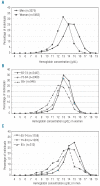Prevalence, incidence and types of mild anemia in the elderly: the "Health and Anemia" population-based study
- PMID: 20534701
- PMCID: PMC2966906
- DOI: 10.3324/haematol.2010.023101
Prevalence, incidence and types of mild anemia in the elderly: the "Health and Anemia" population-based study
Abstract
Background: Hemoglobin concentrations slightly below the lower limit of normal are a common laboratory finding in the elderly, but scant evidence is available on the actual occurrence of mild anemia despite its potential effect on health. The objectives of this study were to estimate the prevalence and incidence of mild grade anemia and to assess the frequency of anemia types in the elderly.
Design and methods: This was a prospective, population-based study in all residents 65 years or older in Biella, Italy.
Results: Blood test results were available for analysis from 8,744 elderly. Hemoglobin concentration decreased and mild anemia increased steadily with increasing age. Mild anemia (defined as a hemoglobin concentration of 10.0-11.9 g/dL in women and 10.0-12.9 g/dL in men) affected 11.8% of the elderly included in the analysis, while the estimated prevalence in the entire population was 11.1%. Before hemoglobin determination, most mildly anemic individuals perceived themselves as non-anemic. Chronic disease anemia, thalassemia trait, and renal insufficiency were the most frequent types of mild anemia. The underlying cause of mild anemia remained unexplained in 26.4% of the cases, almost one third of which might be accounted for by myelodysplastic syndromes. In a random sample of non-anemic elderly at baseline (n=529), after about 2 years, the annual incidence rate of mild anemia was 22.5 per 1000 person-years and increased with increasing age.
Conclusions: The prevalence and incidence of mild anemia increase with age and mild anemia affects more than one out of ten elderly individuals. Unexplained anemia is common and may be due to myelodysplastic syndromes in some cases.
Figures


References
-
- World Health Organization. Nutritional Anemia: Report of a WHO Scientific Group. Tech Rep Ser. 1968;405:1–40. - PubMed
-
- Carmel R. Anemia and aging: an overview of clinical, diagnostic and biological issues. Blood Reviews. 2001;15(1):9–18. - PubMed
-
- Nissenson AR, Goodnough LT. Anemia. Not just an innocent bystander? Arch Intern Med. 2003;163(12):1400–4. - PubMed
-
- Lipschitz D. Medical and functional consequences of anemia in the elderly. J Am Geriatr Soc. 2003;51(3 suppl):S10–S3. - PubMed
Publication types
MeSH terms
Substances
LinkOut - more resources
Full Text Sources
Other Literature Sources
Medical

